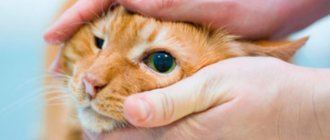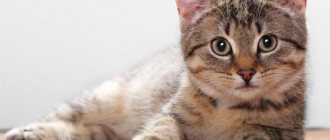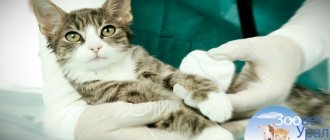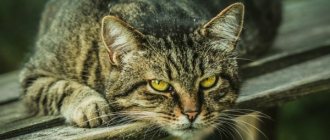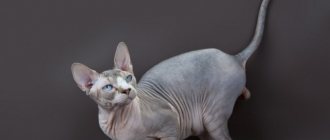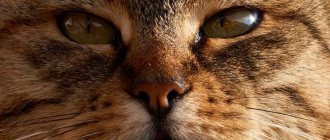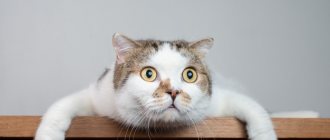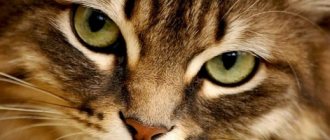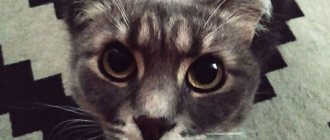- Cats
The striking shine in your cat's eyes in the dark may seem like a clever trick that your pet is performing, as if flirting with you. But, in fact, the glowing eyes of a cat are inherent in its biology. Cats have certain anatomical features in their eyes that humans do not have. For example, the tapetum is a special layer of the choroid of the vertebrate eye. The location, appearance, and microstructure of the tapetum vary among different groups of animals.
Structure
Located behind the retina, it is a “mirror”, a reflective membrane. Covers the entire fundus or part of it, visually reminiscent of mother-of-pearl. It consists of guanine crystals and may contain admixtures of various pigments, giving it a blue, green or yellow tint.
How it works?
In fact, cat's eyes have a lot in common with the human eye apparatus.
A cat's eyes are made up of three main layers:
- External. Consists of a thin, transparent cornea (it occupies ¼ of the part) and sclera, a thick, opaque layer.
- Medium. It is located between the sclera and the cornea. The tasks of this vascular part include providing the eye organ with oxygen and nutrition. The ciliary body is located in the area where the sclera connects to the cornea. This is the septum that holds the lens and passes into the iris. In the central part is the pupil.
- Interior. Or the retina, consisting of cones and rods. Rods enable purrs to see at night, and cones provide daytime vision. Catfish have 25 times more rods than cones. The inner layer converts the captured light and sends signals to the nerve region.
Light passing through the pupil enters the inner chamber of the eye and is reflected from a layer of cells, the surface of which is shiny. This mirror-like surface instantly reflects light back onto the retina. This is why cats see so well in the dark, but on one condition: there must be at least a small source of light. It is only due to an external light source that a cat’s eyes sparkle and shine so brightly. If you place a cat in a completely dark room, without a single source of light, then in such darkness the eyes will not glare and the cat will not be able to see anything. She will need to get out of this darkness relying only on her excellent sense of smell and hearing.
How to treat.
Attention!
If you suspect a health problem with your pet, you should immediately contact a veterinary clinic or veterinarian! Under no circumstances should you self-medicate an animal!
Only a veterinarian can tell you how to treat pathologies of a cat’s eyeball. It is better not to self-medicate, as well as look for medications and help on the Internet.
But you can protect your pet from diseases. There are many different ways to do this that are available to any responsible owner.
Cats and vitamins.
- If your cat has access to the outdoors, you should be more attentive to its surroundings and monitor the animal, trying to prevent fights or attacks by larger animals.
- It is necessary to ensure that the animal gets taurine. The pet products market offers a sufficient amount of food that already contains the necessary amino acids. Even more essential substances can be found in vitamins and dietary supplements for animals.
- If your animal is fed at home, you should always ensure that the diet includes foods containing taurine. Such products include chicken, fish, beef, turkey, cheese, dairy and fermented milk products.
- Timely consultations and preventive examinations with a veterinarian are the key to the health of the pet and the peace of mind of the owner.
If your cat has eye health problems, don’t panic right away. Thanks to numerous clinics and accessible veterinary medicine, you can take the problem into your own hands and quickly help your beloved animal without consequences or serious intervention.
Healthy cat.
Biological functions
In the eyes of many vertebrates, it serves as a biological reflective system, necessary primarily for night vision. Most of the light entering the eye passes through the retina, and only a small percentage of it causes the sensory cells to respond. The tapetum directs photons that have passed through the retina that did not interact with the retinal receptors back to the retina to increase the number of photons absorbed. In twilight conditions (low light intensity), such double stimulation of photoreceptors turns out to be very valuable, but in bright light, the increased sensitivity of the retina negatively affects visual activity.
The presence of tapetum causes the “eye glow” effect in many animals. In reality, the eyes do not glow, but only reflect the light that enters them, so in complete darkness it is impossible to notice this effect.
How to explain to children.
The owners of the furry creature and at the same time parents may notice their child’s tension in the evenings at certain times. For example, a baby absolutely does not want to let a cat into his room at night. Or he tries to avoid contact with his pet altogether. There can be many reasons and you need to deal with them immediately. And a fairly common cause is the glow of the animal’s eyes in the dark, which can frighten the baby.
Cats and children are best friends.
There are different ways to explain to children the reason for glowing cat eyes. Believing families can explain this phenomenon with a legend from their religion. For example, Christians can talk about the Lord who endowed a cat with his light so that it would drive away darkness from its owners.
If the parent does not want to mislead the child and wants to explain everything scientifically, a question arises. How can this be done so as not to break the baby’s brain, but so that he understands everything? And it turns out it's quite easy.
You can show the child a mirror and explain that in the eyes of a cat there is the same small mirror that reflects light, which is why such a phenomenon as the glow of the eyes appears.
You can show your child how it all works using a simple example. To do this, you need to take a flashlight and shine the light on the mirror. The flashing bright spot can be associated with the glowing cat's eyes, explaining to the child that the cat's eye works the same way.
Cause for concern?
Typically, cats' tapetum is well protected as it is located behind the retina, so you don't have to worry about it. However, a deficiency of taurine and some other amino acids found in meat and fish can lead to tapetum disorders. Most commercial feeds contain sufficient taurine to prevent this type of deficiency. However, if you are preparing your cat's food at home, you may want to consult with your veterinarian to ensure that your cat is receiving the correct amount of taurine to maintain its health.
Is it a pathology?
The absence of light reflection in the eyeball clearly indicates pathology and health problems of the animal. Most often, such problems affect elderly and old cats - the lens of the eye thickens and begins to reflect less light.
Problems may also indicate a serious cat disease such as cataracts or glaucoma. Or for injuries that can be received by a pet under various circumstances - from an accident at home, ending with the outcome of a fight between another cat or dogs.
The pathology of lack of light reflection can accompany a kitten from its very birth. There is no way to influence this process without surgical intervention. Why might this happen? Due to improper formation of fetal organs in the womb. However, in this situation, the kittens live and grow up safely, and there is no risk of death. But it can lead to problems with other body processes.
Do people have something similar?
- The rarest cat breeds
- German Shepherd
- What kind of snakes are kept at home?
- Ancient dog breeds
- Dog's sense of smell
- Maine Coon
The reflectivity of the tapetum lucidum layer is much higher than the reflectivity of the retina. Redness in the eyes of animals is not observed because the red color is replaced by the color of the substance that makes up the reflective layer. Although the pigments of the retina and pupil also affect the color of the glow, this influence is very small, and most of the light reflected by the animal's eye returns back almost unchanged. It is because of the lack of a special layer that people's eyes can look red. Moreover, they look like this only in photographs, and not in the rays of a flashlight. The retina has low reflectivity, and it can only shine during a very strong and short-term flash. The camera flash produces a huge amount of light, and this light is directed into the person's face. Some cameras can eliminate red-eye by firing two flashes within a very short period of time. During the first flash, our pupil reflexively contracts, and does not allow too much light into the eye, which can then be reflected by the retina, and because of which our eyes in the photo will look like the eyes of a vampire.
Green, yellow, red - cats' eyes glow differently
The reflective layer of the retina (tapetum) is of two types - tapetum lucidum and tapetum nigrum. Most cats have the first type, which is highly saturated with luminescent pigment. It is similar to mother of pearl and its color varies from yellow to green. At the same time, in the center there is more golden-green, and at the edges there is more bluish-green. The eyes of cats with this type of tapetum glow yellow, yellow-green or blue-green.
The shade of the eye glow also depends on the angle of incidence of the light rays. If the light hits a cat with a well-pigmented tapetum directly at the center of the pupils, the glow will be as bright as possible, light yellow or greenish-golden. In side light, the eyes will glow with turquoise, bluish or violet light.
The eyes of kittens up to 3 months sparkle in the dark with faint reddish reflections, because their retina is still weakly pigmented, and the reflective layer has not fully formed. As the kitten grows, the retina accumulates luminescent pigment, and the eyes begin to glow yellow or green in the dark.
But in some cats (for example, Siamese), the tapetum can remain crimson throughout its life. In the dark, the eyes of such cats glow red, since the light entering through the pupils in this case is reflected to a greater extent from the blood vessels. This effect is generally seen predominantly in blue-eyed cats. And all because they got tapetum nigrum - a version of tapetum with a low content of luminous pigment.
Myths and legends
Because of its ability to reflect light, people attributed the unfortunate purr to the messenger of the devil. Poor cats were oppressed and poisoned. The countries of medieval Europe were especially successful in this - in a dark time, furry creatures were classified as evil spirits and drowned/burned along with the rest of the “sorcerers” and “witches”.
Only huge infestations of rats, bringing with them deadly diseases, sobered people up, and the purr received rehabilitation. What does mysticism say about magical luminous vision?
Ancient Egypt
The graceful animal was the faithful companion of the goddess Bastet, who lived on the Moon. Every night the deity descended to earth and protected people and their livestock from attacks by predators. But Bastet could not always visit the land - her duties included other matters. In order not to leave people unattended, the goddess sent her faithful servant, a graceful cat, to Earth.
Since then, the cat has lived next to people, treated them, protected them, and every night reported on completed tasks to its mistress. At these moments, the animal’s eyes “turn on” - she communicates with the mistress.
For the ancient Egyptians, the purr was a symbol of fertility, life and well-being. For the murder of a fluffy, the culprit was punishable by death. When a pet died a natural death, family members shaved their hair and pulled out their eyebrows as a sign of grief. The deceased cat was embalmed and buried with honors in special cemeteries.
Ancient Rome
Proud Mediterranean people associated the cat with independence and freedom. The inhabitants of Italy had a legend that one evil and cruel Roman kept a circus consisting of animals. The poor animals suffered in captivity and dreamed of escape. Only a fearless cat was able to fulfill her cherished dream - on a gloomy night she gnawed through her bonds and rushed to freedom.
The Roman goddess of freedom Libertas, admiring the animal's love of freedom, gave the cat an amazing feature - to illuminate its path with its eyes. Since then, the independent creature received complete freedom and could choose its own owners. And at night, the cat’s eyes glow as if from electricity, reminiscent of a fearless escape.
Japan
According to the Japanese hypothesis, the cat was endowed with this feature by the Supreme Gods and made her the patroness of the greatest temple “Maneik-Neko”, a sanctuary of good luck and happiness. The mystical animal walks near the temple at night and if her luminous gaze touches a person, he has the great honor of being caressed by fate.
Thanks to the study of the properties of tapetum, scientists were able to invent many useful things. For example, flickers (reflectors). These are devices that are designed to reflect light towards a source with minimal scattering. Most often, road signs, bicycles, road markings, and clothing of traffic controllers are equipped with such devices. And the basis of the operation of all these devices was seen in the eyes of mystical and mysterious creatures - cats.
Video
What other animals can glow in the dark?
Different animals have different eye glows. The pupils of some of them can glow red, yellow, green, orange or white - it all depends on the structure of the eye.
At night, you can see the glowing eyes of alligators, bears, deer, raccoons, chinchillas, opossums, foxes, owls, rats, skunks, ferrets, camels, lemurs, kangaroos and large felines (such as tigers and panthers). Among domestic animals, this effect is observed in rabbits, dogs, horses, pigs, goats and cows.
Anyone who is planning to get a pet cat should take into account that pets are not fun or toys, although they give many joyful moments to their owner. First of all, it is responsibility for the health and life of the animal. Therefore, you should know how to properly care for your four-legged pet. By following the advice of experts, you can give your pet a long and happy life.
Photo: Pixabay.
Features of vision of cats
The internal organs of a cat are identical to those of other mammals. The same cannot be said about the senses, including the eyes. They are endowed with special properties necessary for the normal functioning of a predator.
In complete darkness, an animal's vision is no different from a human's. In dim light, their orientation improves significantly. The ability to process any accessible light source is increased.
Advantage of the cat's gaze:
- large pupil and lens;
- close location of the cornea to the retina;
- roundness and contraction of the eyeball;
- extended viewing angle.
Glowing eyes Cats have the ability to accumulate light.
The mechanism is called “luminous wallpaper”. It is located behind the retina and consists of 15 spheres. The functioning of an animal's eyes is similar to the working principle of a camera. Light rays sneak through the hole, the dimensional frequencies of which are modified. The quantitative composition of light is controlled by the iris, and focused by the lens. Envelopment of the retina occurs. It sends an impulse to the brain center.
The retina is endowed with sensory cells:
- The first: is responsible for excellent vision at night and sensitivity to movement in dim flickering lamps.
- The second has resolving power.
- The slit pupil provides protection from bright flickering light.
A cat has binocular vision, just like a human. Due to the stereoscopic effect, the predator assesses the reach of prey.
glowing eyes